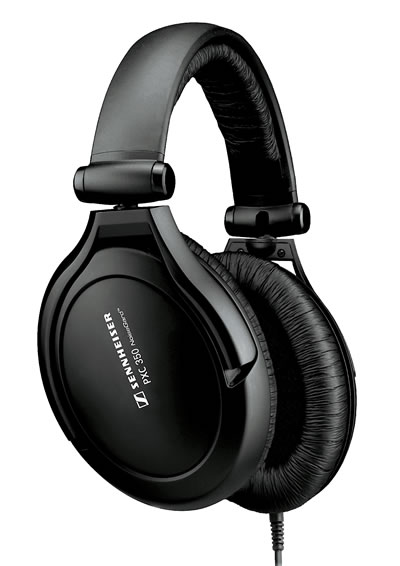Sennheiser PXC 350 Noise Canceling Headphones

Back in October the Sennheiser PXC 450 were rated the best noise canceling headphone on the market, in November a black edition was released dubbed the PXC 350 and retailing for some £70 less. It’s this version I managed to obtain for the Gadgetoid once over, and it didn’t take much more than the insertion of batteries and the flip of just one switch to realize exactly how the Sennheiser PXC 450 stole the noise canceling crown. In fact, the PXC 350s have won the very first Gadgetoid “really rather good” award.
It’s worth noting that the PXC 350s are slightly inferior in noise canceling capabilities to the PXC 450s, bear this in mind because if you’re wowed by the 350 and have a whole lot of cash burning in your pocket you can rocket straight to noise canceling nirvana with their shiny silver bigger brother.

There’s not much to say about the sound quality in the PXC 350, there shouldn’t ever be anything to say about the sound quality in a Sennheiser product unless it’s bad. Rest assured, however, the Sennheiser PXC 350 sound is as far from bad as one would expect with any Sennheiser product. Particularly when it’s priced above the £200 mark. The PXC 350s, being a closed headphone, have a certain degree of noise dampening to prevent you, safe in your cloak of silence, from annoying your neighbors on a bus or flight but rest assured that you will easily attain volume levels high enough to garner dirty looks. The PXC 350s are capable of producing volume levels far in excess of what you will be able to tolerate without even the slightest hint of distortion. You will be able to “feel” bassy EBM or DnB tracks without any compromise to vocals and melodies. Despite their obvious benefit and role as portable audio headphones it seems almost a crime to push nasty, compressed mp3 audio through drivers capable of such pristine sound. If you’re paying over £200 for a pair of headphones and worrying about the audio quality you’d better be listening to CDs, FLAC or have them directly connected to the P.A. system of your favourite band; good drivers can only do so much for overly compressed (both in volume and file size) audio.
Anyway, I’m digressing somewhat here and have left you hanging, what really matters in the PXC 350s is the noise canceling. The noise canceling system is powered by two triple A batteries, one in each headphone. This has the effect of both being extremely tidy, as many cheap noise canceling solutions opt for a very bulky inline battery pack, and adding slightly to the bulk of the headphones themselves. The latter, rest assured, is an acceptable compromise for the former. The headphones are no larger than any typical set of cans and have a fairly average heft to them, like the reassuring heft of an expensive tungsten watch, that you’ll soon get used to. The noise canceling system is turned on with a simple flick of the switch and its status (on or off) is indicated by a red light on the back of the left headphone. Of course whilst you’re wearing the headphones you will not be able to see this light, but when it’s off it is a clear indication of remaining battery life.
On the subject of battery life, it’s exceptional, I have been using the same batteries since beginning my review and have used the headphones on the bus, in the office and at home at length often simply with the audio cable disconnected and using them simply to dampen irritating background noise. Sennheiser claim around 40 hours use, which is more than you will need on most journeys or even long haul flights. They also opt to omit any charging system or proprietary battery solutions to save on traveling bulk and keep things simple. If the batteries run out simply buy and slap in another set of AAAs or carry a couple of rechargeable ones with you spare.
Now, finally, on to the noise canceling itself. The effect is quite simply stunning. Ordinarily closed-back headphones have a certain degree of external noise attenuation that allows you to listen to your music as less-than-painful volumes without being disturbed by every day background noises. Imagine the same effect only with a switch that allows you to wrap a thick pillow around your head to further dampen the sound. It’s not perfect, loud sounds will still penetrate your “cloak of silence” but even for someone like me who typically can not hear much background noise there is a quite dramatic and noticeable reduction. When I first switched the Sennheiser PXC 350s on I had to clutch my jaw to prevent it dropping, they were then promptly passed around the office and gauged similar responses from my colleagues who later even requested to borrow them to cut out the office background noise when trying to concentrate.
Sennheiser have thought of that too. If you want to use the PXC 350s just to cut out some of that pesky office noise you can simply slide out the audio cable from the headphones, flip on the noise canceling, and enjoy a close approximation of silence.
Overall the Sennheiser PXC 350 and, indeed, the superior PXC 450 are fantastic products and they are priced as such. Suffice to say they are geared toward professionals who rack up a lot of air time and can justify a purchase to make it just that little bit more comfortable and tolerable but if you really enjoy your music then the PXC 350s will lend an extra dimension of bassy, clear, loud and uninterrupted sound to even compressed mp3s on a common-old-iPod. Most of us desk-job folk will also gain the benefit of a little office-background-noise canceling when we need it.
In the usual accessory-packed spirit of Sennheiser the PXC 350s also come with a neat little carrying case, it’s a reasonably hard-shelled zip-up affair with a handle and a sculpted interior for your headphones. It’s a great addition but I still haven’t managed to figure out how to correctly stow the cord in it! It’ll keep them from harm in your carry on luggage bag, anyway.
Anyway, it’s the excellent sound, the excellent noise canceling, the portability and the versatility of the PXC 350 that wins them the, perhaps not yet coveted, Gadgetoid 2008 “Really Rather Good Award” for Headphones.
What more can I say, really, other than “they work” and “despite what many might think, they’re worth £220”. I moved recently from the tiny but incredibly popular Sennheiser PXC250s to a set of superior £140 Roland RH-300s (Comparable to the PXC 350 in sound quality) and have never looked back. An extra £60 for noise canceling over the price you would expect to pay for good quality cans isn’t that much of a stretch.